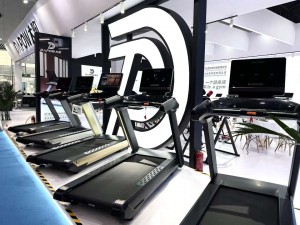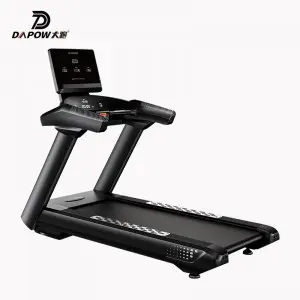Today, with high-intensity interval training (HIIT) sweeping the global fitness field, treadmills are no longer simple aerobic devices but have evolved into professional tools that support dynamic and efficient training. For industry professionals seeking reliable fitness solutions, the emergency start and stop performance of treadmills – that is, the ability to start quickly and stop immediately – has become a core indicator for measuring their commercial value. This article will delve into how this performance meets modern fitness demands and analyze the technical principles and market significance behind it.
First, the rise of high-intensity interval training and the new requirements for equipment
High-intensity interval training effectively enhances heart and lung function, burns fat and boosts muscle endurance by alternating short periods of high-intensity exercise with brief recovery periods. According to the American College of Sports Medicine, HIIT has become one of the fastest-growing fitness trends worldwide, covering a wide range of people from professional athletes to ordinary users. The core of this training mode lies in “intermittency” : athletes need to switch between speed and slope within an extremely short period of time, such as suddenly accelerating from slow walking to sprinting and then rapidly decelerating to a stop. Traditional home treadmills are often designed to operate in a smooth and continuous mode, unable to withstand frequent sudden starts and stops, which can lead to motor overheating, belt slippage or control system delays. Commercial treadmills, on the other hand, ensure seamless switching during high-speed operation by enhancing motor power, optimizing transmission systems and intelligent control modules. For instance, a standard HIIT course may involve more than 20 emergency start-stop cycles, which poses a severe test to the durability and response speed of the treadmill.
Second, Technical analysis of Emergency Start and Stop Performance: Why Do commercial Treadmills Have more advantages
The emergency start-stop performance not only concerns the user experience, but also directly relates to the safety and lifespan of the equipment. Commercial treadmills typically employ high-torque AC motors, with peak horsepower reaching over 4.0HP. They can accelerate from 0 to 16 kilometers per hour within 3 seconds and come to a complete stop within 2 seconds in emergency situations. This performance relies on three major technical pillars:
Power system optimization: High-torque motors combined with variable frequency drive technology can reduce energy loss and prevent circuit overload caused by frequent starts and stops. Meanwhile, the heavy-duty flywheel design can store kinetic energy, ensuring smoothness during acceleration.
Control system response: The integrated digital signal processor (DSP) monitors user actions in real time and predicts speed change requirements through algorithms. For instance, when a user suddenly switches modes, the system will adjust the current output to prevent jerks.
Structural reinforcement design: The steel frame structure, wear-resistant belts and shock-absorbing modules of commercial models have all undergone strict testing and can withstand repeated impacts. Data shows that the emergency start-stop cycle life of high-quality commercial treadmills can reach over 100,000 times, far exceeding the 5,000 times standard of household models.
These technical details not only enhance the reliability of the equipment but also reduce maintenance costs. For gyms or training centers, this means less downtime due to malfunctions and higher member satisfaction.
Third, Safety and User Experience: How does emergency Start and Stop ensure Training effectiveness
In HIIT, the performance of emergency start-stop is directly related to user safety and training efficiency. A failed emergency stop may lead to slipping or muscle strain, while a delayed start can disrupt the training rhythm and affect the peak calorie consumption. Commercial treadmills mitigate risks through the following mechanisms:
Emergency braking system: The magnetic safety key or touch emergency stop button can cut off the power supply within 0.5 seconds, and in combination with high-friction brake pads, achieve rapid braking.
Dynamic shock absorption adjustment: During high-speed start and stop, the suspension system will automatically adjust the hardness, absorb the impact force, and reduce the pressure on the knee joint. Studies show that good shock absorption can reduce the probability of sports injuries by 30%.
Interactive feedback interface: Real-time display of speed, slope and heart rate data, helping users precisely control the interval time. For instance, after the sprint phase is over, the equipment can automatically enter the recovery mode to avoid manual operation errors.
These functions not only meet the requirements of professional coaches for course design, but also enable ordinary users to safely perform complex actions. As a fitness expert put it, “A responsive treadmill is like a reliable training partner, providing you with protection during high-intensity challenges.”
Fourth, Market Trends and Investment Value: Why Does Emergency start-stop Performance Determine Purchasing Decisions
As the penetration rate of HIIT in the global fitness market increases year by year, the demand for commercial treadmills is shifting from “basic functions” to “professional performance”. According to a report by the Fitness Industry Association, more than 60% of commercial gyms list emergency start-stop performance as one of the top three evaluation indicators when purchasing equipment. This trend stems from multiple factors:
Diverse course demands: Modern fitness courses such as circuit training or tabata all rely on the rapid response capability of equipment. Treadmills lacking this feature may not be able to meet the high-intensity pace of group classes.
Long-term economy: Although the initial investment in commercial treadmills is relatively high, their high durability and low failure rate can significantly reduce the frequency of replacement. Data shows that the average service life of high-quality models can reach over 7 years, and the annual maintenance cost is 40% lower than that of household models.
Member retention impact: The smooth experience of the device is directly related to user satisfaction. A club survey shows that the renewal rate of members in venues equipped with high-performance treadmills has increased by approximately 15%.
For industry decision-makers, investing in treadmills with emergency start and stop capabilities is not only about upgrading hardware but also a strategic choice to enhance service competitiveness.
Fifth, Future Outlook: How will technological Innovation Reshape the Role of Treadmills
The evolution of treadmills has not stopped at the present. With the development of the Internet of Things and artificial intelligence, emergency start-stop performance is deeply integrated with intelligent systems. For instance, the next-generation commercial models might predict user movements through biosensors to achieve “zero-delay” start and stop. Or analyze the training data through the cloud platform to automatically optimize the intermittent plan. These innovations will further narrow the gap between devices and human movement, making treadmills an indispensable intelligent node in the HIIT ecosystem.
In conclusion, in the fitness era dominated by high-intensity interval training, the emergency start and stop performance of treadmills has evolved from an additional function to a core requirement. It integrates engineering, safety science and user experience design to provide lasting value for commercial Spaces. Choosing a treadmill that is truly competent for HIIT means embracing a revolution in fitness efficiency.
Post time: Oct-21-2025



